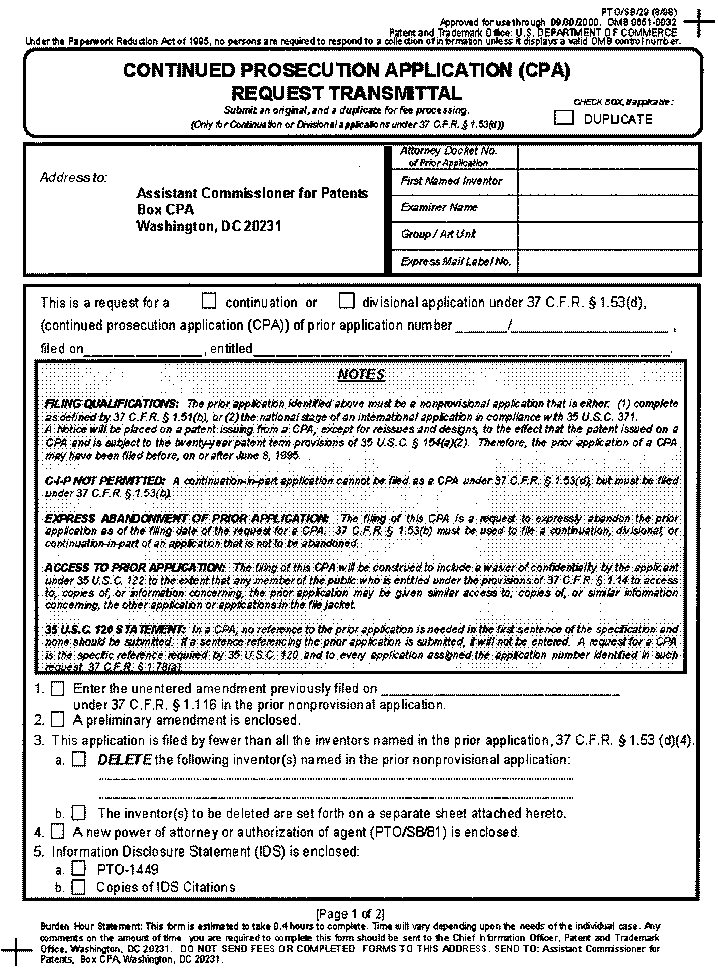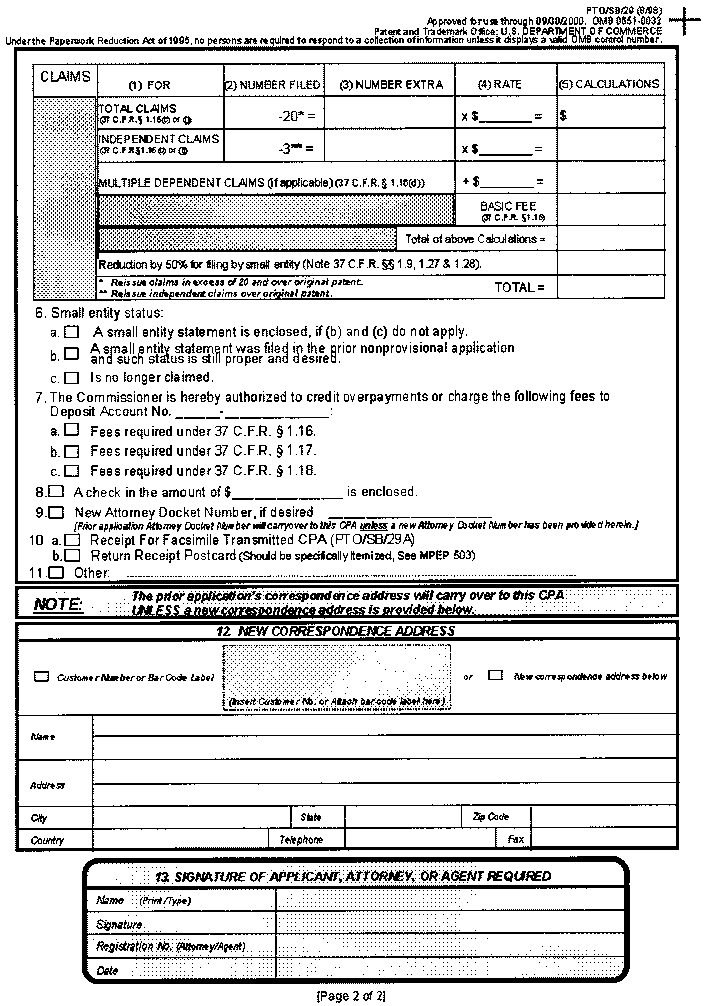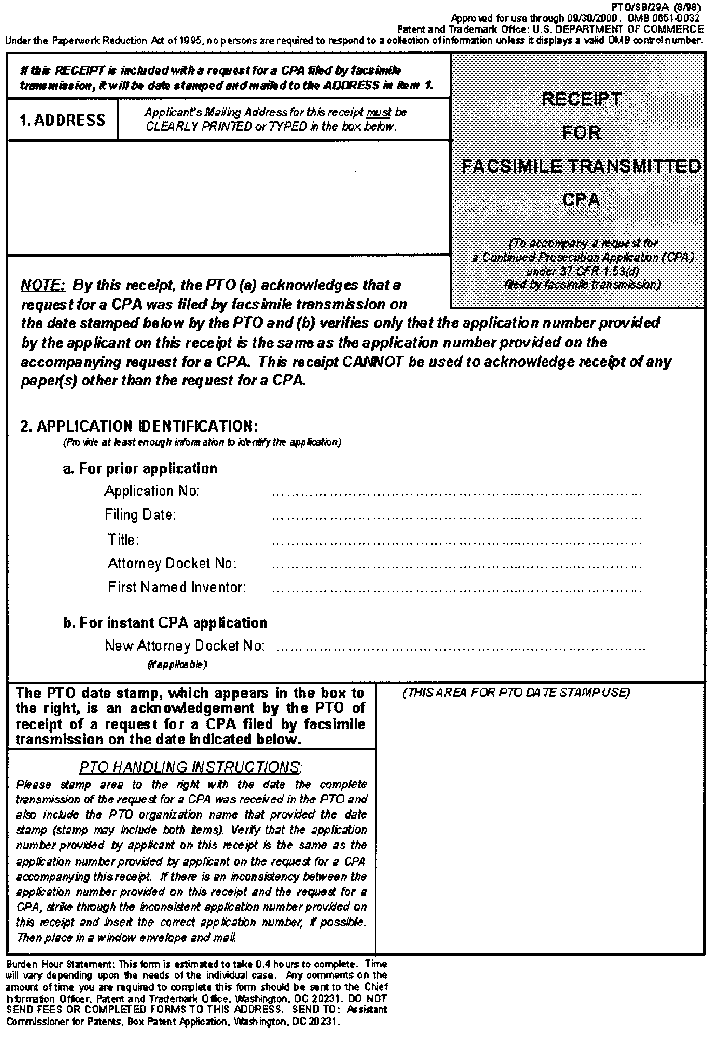(273) Continued Prosecution Application
(CPA) Practice
Summary: This notice will clarify how the Patent and
Trademark Office (PTO) processes requests for a continued prosecution
application (CPA) under 37 C.F.R. 1.53(d), indicate that patent
examiners act on a CPA with priority, and, in addition, inform the
public about a new PTO service to acknowledge receipt of a request for a
CPA which has been transmitted by facsimile to the PTO.
First: If a request for a CPA also includes an instruction and/or
reference that is inconsistent with the CPA practice (e.g., an
instruction "not to abandon the prior application" and/or a reference to
a "continuation-in-part CPA" and/or "CPA under 37 C.F.R. 1.53(b)"),
the request will be processed by the PTO solely as a request for a
continuation CPA under 37 C.F.R. 1.53(d) (unless it is also
designated as a divisional application, in which case the request will
be processed as a request for a divisional CPA under 37 C.F.R.
1.53(d)) and the inconsistent instruction and/or reference will be
ignored.
Second: The PTO will treat continuation CPAs, for examination priority
purposes only, as if they were "amended" applications (as of the CPA
filing date) and not as "new" applications. As "amended" applications
generally have a shorter time frame for being acted on by examiners than
"new" applications, this treatment (of CPAs as "amended" applications)
will result in first Office actions being mailed in continuation CPAs
much sooner than if they had been filed as continuations under 37 C.F.R.
1.53(b) (or under former 37 C.F.R. 1.60 or 1.62). Therefore,
applicants are strongly encouraged to file any preliminary amendment in
a CPA at the time the CPA is filed.
Third: The PTO shall offer, as a new service, the following: The PTO
will acknowledge receipt of a CPA filed by facsimile transmission, if:
(1) the CPA is accompanied by a "Receipt for Facsimile Transmitted CPA"
(PTO/SB/29A) properly identifying the prior application; and (2) the CPA
is transmitted by facsimile directly to a technology center/examining
group. The PTO will stamp the "Receipt for Facsimile Transmitted CPA"
with the date of receipt of the CPA and return the "Receipt for
Facsimile Transmitted CPA" by mail to the mailing address indicated
thereon. The CPA request form (PTO/SB/29) has been modified to include a
separate "Receipt for Facsimile Transmitted CPA" (PTO/SB/29A) which must
be used in order to take advantage of this new service.
Discussion: Effective December 1, 1997, the PTO adopted the CPA practice
(37 C.F.R. 1.53(d)) to provide a streamlined procedure to obtain
further examination via a continuation/divisional application. See
Changes to Patent Practice and Procedure; Final Rule Notice, 62 Fed.
Reg. 53131 (October 10, 1997), 1203 Off. Gaz. Pat. Office 63 (October
21, 1997), and Changes to Continued Prosecution Application Practice;
Interim Rule Notice, 63 Fed. Reg. 5732 (February 4, 1998), 1207 Off.
Gaz. Pat. Office 83 (February 24, 1998).
With respect to the first subject: A CPA, by definition, is an
application filed under 37 C.F.R. 1.53(d). The filing of a CPA is, by
rule, a request to expressly abandon the prior application as of the
filing date of the CPA. See 37 C.F.R. 1.53(d)(2)(v). An applicant may
file a continuation or divisional application as a CPA, but a
continuation-in-pan may not be filed as a CPA. See 37 C.F.R.
1.53(d)(1); see also 37 C.F.R. 1.53(b)(2) (a continuation-in-part
must be filed under this paragraph) and 1.53(d)(5) (no amendment in a
CPA may introduce new matter or matter that would have been new matter
in the prior application). The PTO, however, has received a number of
papers requesting a CPA, but also containing some instruction and/or
reference that is inconsistent with the CPA practice. Since streamlined
 Top of Notices (273) December 28, 2010 Top of Notices (273) December 28, 2010 |
US PATENT AND TRADEMARK OFFICE |
1361 CNOG 1557 |
processing is the essence of the CPA practice, the PTO will not hold the
request to be improper and deny a filing date to a CPA simply because it
contains an instruction and/or reference that is inconsistent with the
CPA practice. Rather, assuming that the request otherwise meets the
requirements to be entitled to a filing date as a CPA (see 37 C.F.R.
1.53(d)(1)), the inconsistent instruction and/or reference will be
ignored and the request will be processed solely as a request for a
continuation (or divisional, if so indicated) CPA under 37 C.F.R.
1.53(d).
If applicant wants the PTO to disregard a previously filed request
for a CPA (and not recognize its inherent request to expressly abandon
the prior application) and to treat the paper as the filing of an
application under 37 C.F.R. 1.53(b), the applicant must file a
petition under 37 C.F.R. 1.182. A request to expressly abandon an
application is not effective until the abandonment is acknowledged,
including the express abandonment of the prior application of a CPA that
occurs by operation of 37 C.F.R. 1.53(d)(2)(v). See Changes to Patent
Practice and Procedure; Training and Implementation Guide, Question and
Answer 66 (December 1997). The express abandonment of the prior
application is acknowledged and becomes effective upon processing and
entry of the CPA into the file of the prior application. Thus, such a
petition under 37 C.F.R. 1.182 should be filed expeditiously since
the petition will not be granted once the request for a CPA has been
entered into the prior application (and the inherent request to
expressly abandon the prior application has been acknowledged). If the
request for a CPA has been entered into the prior application by the
time the petition under 37 C.F.R. 1.182 and the application file are
before the deciding official for a decision on the petition, the
petition will be denied.
It is noted, however, that if the applicant intended to file a second
application (either a continuation or a divisional) without abandoning
the prior application, applicant can still achieve that result without
loss of the benefit of the original filing date by: (1) continuing the
prosecution of the original application via the CPA; and (2) filing a
new continuation/divisional under 37 C.F.R. 1.53(b) claiming benefit
of the CPA and its parent applications under 35 U.S.C. 120 during the
pendency of the CPA.
Any (new) specification filed with a CPA request will not be considered
pan of the original CPA papers, but will be treated as a submission of a
substitute specification in accordance with 37 C.F.R. 1.125. See 37
C.F.R. 1.53(d)(5). Thus, applicant will have to comply with the
requirements of 37 C.F.R. 1.125(b) before the substitute
specification will be entered into the CPA. See Changes to Patent
Practice and Procedure; Training and Implementation Guide, Question and
Answer 61. Since 37 C.F.R. 1.125(b) requires that a substitute
specification be accompanied by, inter alia, a statement that the
substitute specification includes no new matter, any substitute
specification containing new matter will be denied entry by the
examiner. Any preliminary amendment to the written description and
claims, other than a substitute specification, filed with a CPA request
will ordinarily be entered. Any new matter which is entered, however,
will be required to be canceled pursuant to 35 U.S.C. 132 from the
descriptive portion of the specification. See Final Rule Notice, 62 Fed.
Reg. at 53141, 1203 Off. Gaz. Pat. Office at 71. Further, any claim(s)
which relies upon such new matter for support will be rejected under 35
U.S.C. Z 112, first paragraph. See MPEP 2163.06.
In the event that a substitute specification or preliminary amendment
containing new matter was filed with a request for a CPA, applicant may
file a petition under 37 C.F.R. 1.182 requesting that the substitute
specification or preliminary amendment be removed from the CPA
application file, and be accorded the status as a separate application
by being placed in a new file wrapper and assigned a new application
 Top of Notices (273) December 28, 2010 Top of Notices (273) December 28, 2010 |
US PATENT AND TRADEMARK OFFICE |
1361 CNOG 1558 |
number, with the new application being accorded a filing date as of the
date the request for a CPA and substitute specification/preliminary
amendment were filed.
Of course, a request for a CPA is not improper simply because the
request is accompanied by a substitute specification or preliminary
amendment containing new matter. Thus, an applicant will not be entitled
to a refund of the filing fee paid in a proper CPA as a result of the
granting of a petition under 37 C.F.R. 1.182 requesting that the
substitute specification or preliminary amendment be removed from the
CPA application file.
With respect to the second subject: The PTO has received several
comments from practitioners who have been surprised at receiving a first
Office action (in a CPA application) fairly quickly after filing a
request for the CPA. The CPA procedure permits the PTO to perform all
pre-examination processing of a CPA in a technology center/examining
group to which the prior application is assigned, which reduces the time
it takes to provide a first Office action in a CPA. See Final Rule
Notice, 62 Fed. Reg. at 53145, 1203 Off. Gaz. Pat. Office at 74
(response to comment 29). In addition, the PTO has decided to treat all
continuation CPAs, for examination priority purposes only, as though
they are amended applications (as of the filing date of the CPA) which
generally results in examiners acting on the CPAs fairly quickly, as
amended applications will ordinarily be acted on by examiners within one
or two months of docketing of the applications to the examiners. As a
result, continuation CPAs would be acted on by an examiner much sooner
than if they were treated, for examination priority purposes, as new
applications. See Final Rule Notice, 62 Fed. Reg. at 53144, 1203 Off.
Gaz. Pat. Office at 74 (comment 27). Therefore, applicants are strongly
encouraged to file any preliminary amendment in a CPA at the time the
CPA is filed, especially where the preliminary amendment is a
resubmission of an amendment filed after final rejection which was
denied entry via an advisory action in the prior application. While the
PTO consistently encourages applicants to file a complete application in
condition for examination, applicants should note that the PTO will not
examine a CPA, or any new application, until the appropriate filing fee
(37 C.F.R. 1.16) has been submitted. Applicants should also note,
however, that deposit account charge authorizations carry-over to a CPA
from the prior application. See Changes to Patent Practice and
Procedure; Training and Implementation Guide, Question and Answer 39.
Thus, an authorization in the prior application to charge all fees, fees
under 37 C.F.R. 1.16, or filing fees to a deposit account in the
prior application will be treated as payment of the basic filing fee
(and result in a charge to the deposit account) in a CPA of the prior
application.
With respect to the third subject: While 37 C.F.R. 1.6(f) provides a
remedy (if the appropriate records are maintained) in the event that a
CPA transmitted to the PTO by facsimile is lost, the PTO has received
several comments from practitioners indicating that they do not file
CPAs by facsimile transmission due to the lack of a prompt
acknowledgment of receipt of the CPA by the PTO. To address this
concern, the PTO has decided that it will acknowledge receipt of
requests for CPAs transmitted to the PTO by facsimile, if: (1) the CPA
is accompanied by a "Receipt for Facsimile Transmitted CPA" (PTO/SB/29A)
properly identifying the prior application; and (2) the CPA is
transmitted by facsimile directly to a technology center/examining group.
The PTO has modified its CPA request form (PTO/SB/29) to include a
separate "Receipt for Facsimile Transmitted CPA" (PTO/SB/29A). A CPA
request form (PTO/SB/29) including a "Receipt for Facsimile Transmitted
CPA" (PTO/SB/29A) is appended to this notice for illustrative purposes.
Applicants are not required to use the PTO created "Receipt for
Facsimile Transmitted CPA" (PTO/SB/29A), or the PTO created CPA request
form (PTO/SB/29), when filing a CPA. The PTO, however, will acknowledge
 Top of Notices (273) December 28, 2010 Top of Notices (273) December 28, 2010 |
US PATENT AND TRADEMARK OFFICE |
1361 CNOG 1559 |
receipt of a facsimile transmitted CPA as set out in this notice only if
the CPA is accompanied by a copy of the PTO created "Receipt for
Facsimile Transmitted CPA" (PTO/SB/29A) completed by the applicant, and
will not acknowledge non-PTO versions of a "Receipt for Facsimile
Transmitted CPA."
A request for a CPA transmitted to the PTO by facsimile should be
transmitted directly to the technology center/examining group to which
the prior application is assigned. See Changes to Patent Practice and
Procedure; Training and Implementation Guide, Question and Answer 44. In
order to encourage applicants to transmit CPA requests directly to the
technology centers/examining groups, the PTO will only acknowledge
receipt of a CPA request filed by facsimile transmission where the CPA
request is transmitted directly to a technology center/examining group.
All PTO forms, including the CPA request form (PTO/SB/29) and "Receipt
for Facsimile Transmitted CPA" (PTO/SB/29A), are available on the PTO
Home Page, either individually or in a single zip-compressed file from
the PTO ftp server at ftp://ftp.uspto.gov/pub/forms/. Individual forms
for patent and trademark submissions can also be requested from
800-PTO-8199 or 703-308-HELP. A specimen book of Patent Forms can be
purchased for $25 from the Office of Electronic Information Products,
telephone number 703-306-2600.
Applicants filing a CPA by facsimile transmission may include a "Receipt
for Facsimile Transmitted CPA" (PTO/SB/29A) containing a mailing address
and identifying information (e.g., the prior application number, filing
date, title, first named inventor) with the request for a CPA. The PTO
will: (1) separate the "Receipt for Facsimile Transmitted CPA" from the
CPA request papers; (2) date-stamp the "Receipt for Facsimile
Transmitted CPA"; (3) verify that the identifying information provided
by the applicant on the "Receipt for Facsimile Transmitted CPA" is the
same information provided on the accompanying request for a CPA; and (4)
mail the "Receipt for Facsimile Transmitted CPA" to the mailing address
provided on the "Receipt for Facsimile Transmitted CPA." The "Receipt
for Facsimile Transmitted CPA" cannot be used to acknowledge receipt of
any paper(s) other than the request for a CPA.
A returned "Receipt for Facsimile Transmitted CPA" may be used as prima
facie evidence that a request for a CPA containing the identifying
information provided on the "Receipt for Facsimile Transmitted CPA" was
filed by facsimile transmission on the date stamped thereon by the PTO.
As the PTO will verify only the identifying information contained on the
request for a CPA, and will not verify whether the CPA was accompanied
by other papers (e.g., a preliminary amendment), the "Receipt for
Facsimile Transmitted CPA" cannot be used as evidence that papers other
than a CPA were filed by facsimile transmission in the PTO. Likewise,
applicant-created "receipts" for acknowledgment of facsimile transmitted
papers (whether created for the acknowledgment of a CPA or other papers)
cannot be used as evidence that papers were filed by facsimile in the
PTO.
Finally, applicants are cautioned not to include information on a
"Receipt for Facsimile Transmitted CPA" that is intended for retention
in the application file, as the PTO does not plan on retaining a copy of
such receipts in the file of the application.
Inquiries regarding this matter should be directed to Fred A. Silverberg
or John F. Gonzales, Senior Legal Advisors, at (703) 305-9285.
August 12, 1998 STEPHAN G. KUNIN
Deputy Assistant Commissioner
for Patent Policy and Projects
[1214 OG 32]





